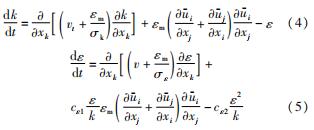基金项目:国防科技工业局支持项目
作者简介:孙得川(1973—),男,博士,教授,研究领域为火箭发动机工作过程仿真。
1.大连理工大学 工业装备结构分析优化与CAE软件全国重点实验室,辽宁 大连 116024; 2.上海空间推进研究所,上海 201112
1.State Key Laboratory of Structural Analysis, Optimization and CAE Software for Industrial Equipment,Dalian University of Technology, Dalian 116024, China; 2. Shanghai Institute of Space Propulsion, Shanghai 201112, China
rocket engine; test firing; aerodynamic noise; noise reduction; numerical simulation
DOI: 10.3969/j.issn.1672-9374.2024.02.003
21世纪以来,世界各国对太空资源愈加重视,使得航天技术发展迅猛,而液体火箭发动机是进入太空的关键[1]。在研究液体火箭发动机时,发动机热试车是发动机研制过程中非常重要的一种手段[2]。而在发动机地面热试车时,尾喷流会产生强烈的气动噪声,对附近的人员、设备和环境产生不利影响,因此其噪声控制一直是试验技术所关注并致力解决的问题[3-4]。
对于发动机尾喷流降噪,采用喷水措施一直是主流方案[5]。如20世纪60年代美国在火箭发射架的导流设施出入口处设置喷水系统,用于运载火箭发射的降温降噪[6]; 20世纪70年代末至80年代初,美国、苏联、中国几乎同时将该技术应用于战略导弹武器系统,开发了燃气-蒸汽式冷弹射系统[7]; 20世纪90年代欧洲航天局(ESA)开发阿里安5运载火箭发射喷水降噪技术[8]; 以及近年在猎鹰重型运载火箭喷水降噪系统方面的研究。
此外,国内外针对喷流噪声进行了很多研究。在射流噪声机理研究方面,郑克扬等[9]进行了喷管射流的实验,研究了声功率和射流速度之间的关系,验证了降低流速能减小射流噪声,另外还指出射流噪声的指向性受射流速度影响,流速越大,指向角度越大。徐强等[10]对某火箭发动机喷流的近场噪声特性进行了测量,指出近场噪声的幅值与燃烧室压强有关,喷管构型影响噪声的频率分布。周月荣等[11]测量分析了不同压比条件下喷管所产生的射流噪声,指出在一定频率范围内,低频段射流噪声与静压比成正比关系,射流噪声的大小与喷管的形状、出口尺寸和静压比有关。彭小波等[12]研究了不同喉颈尺寸喷管射流的噪声特性及声场分布规律,超声速射流噪声指向性十分明显,声压级和压强、喷管尺寸存在正比关系。陈海峰等[13]对某型号液体火箭发动机的试车状态进行了噪声测量,得到该型发动机试车噪声的主要频率集中在1~2 kHz的较窄频率范围内,且噪声主要是混合噪声。孙得川等[14]对不同类型发动机的射流流场及噪声进行了计算和分析,指出排气场声功率级的分布与湍流强度的分布具有相似性,声功率级影响区域呈现锥形分布的特征,发动机喷流噪声的频率范围较大,主频随着推力增大而降低的原因是下游大尺度涡脉动引起的低频噪声增强。
在发动机喷流降噪研究方面,徐悦等[15]研究了喷水前后发动机喷流流场和声场特性,指出喷水能使射流噪声幅值降低,当水和燃气的质量流率比超过临界值时,降噪效率会降低。文献[16-17]为低涵道比涡扇发动机开发了一种主动降噪技术,在喷管扩张段注入流体,通过改变喷流位置和参数,获得了混合噪声和冲击噪声的主动降噪。Tsutsumi等[18]利用缩比模型研究了Epsilon运载火箭发动机发射噪声,通过设计发射架导流装置使喷流马赫波偏转和衰减,以达到降噪的目的。陈劲松等[19]对火箭喷水降噪机理进行了试验研究,发现常温水喷入高速射流后会迅速雾化,降低高速射流的噪声功率,同时喷水阻断了射流噪声的传播路径,抑制宽频噪声对射流中的啸音也有抑制作用。Zolla等[20]提出了一种适用于火箭发动机的喷水噪声抑制系统的简化设计程序,并采用该程序设计了15 kN氧气/甲烷液体火箭发动机的降噪,但该系统的降噪效果不明显。
从现有研究来看,针对火箭发动机试车时的降噪研究还较少,所提方案的降噪效果有限。为此,本文针对中小推力发动机提出了不同的组合降噪方案,并采用数值模拟的方法对采用降噪方案的稳态喷流流场进行了仿真研究,预测降噪方案的效果并为其实施提供数据支撑。
发动机在地面试车时会产生强烈的噪声,其来源主要有以下3个。
1)超声速燃气流与周围大气的混合。当高速射流喷入相对静止的大气环境时,射流气体与周围的气体急剧混合,在射流边界层中形成强烈的湍流脉动。湍流脉动引起压力脉动和密度脉动,即产生了声波,这就是射流混合引起噪声的物理原因。
2)排气流内部的湍流和激波。当气体穿过激波后,状态参数发生阶跃变化,所以它会产生强烈的声音。另外,发动机射流中的激波会与射流边界相互作用,激波/边界层干扰形成了更强的湍流掺混作用,也会产生射流激波噪声。
3)当发动机正常工作,不发生燃烧不稳定现象时,燃烧室中的湍流燃烧和富燃气体射流在大气中的二次燃烧也是发动机试车时的主要噪声源。
采用向射流中喷水来抑制噪声的原理是:水加入射流混合边界层后,首先会由于动量交换的原因降低湍流的强度,从而降低由湍流脉动引起的噪声; 其次,会降低喷水局部的燃气温度和速度,降低声功率; 此外,水雾中的大量液滴对声音有反射和散射作用,对声波形成阻尼。
根据降噪的原理,降噪方案围绕降低源头噪声和阻隔、衰减气动噪声来设计。因此,降噪方案不仅包含向燃气流喷水,同时还要布置吸、隔声装置,以达到进一步降低噪声的目的。
根据上述降噪原理,针对中小推力发动机试车,采用了多重降噪措施,其方案如图1所示。对于发动机尾喷流,最有效的降噪形式就是隔声结构。因此,为了不影响发动机试车,在发动机喷管出口下游设置锥形引射筒,形成第一道隔声结构。在锥形引射筒段设置喷水装置,用以降低发动机喷流燃气的温度。因为喷流较长,所以在锥形引射筒下游加装圆筒段,进一步隔声和整流。最后,在距离喷流较远的区域对小推力和中等推力发动机区别处理。对于小推力发动机,因喷流流量小,故采用交叉布局的消声结构,进一步降低喷流的湍流度,以最大程度地降低噪声; 对于中等推力的发动机,因流量较大,为保证流动通畅,仍采用管道整流来降低湍流度和噪声,同时为了排水顺畅,尾部管道下倾。在消声管道后侧及两侧安装金属吸隔声屏障,其上部也可安装喷水装置,可形成水雾,达到进一步隔声的目的。
引射筒长1.5 m,等距分布4道喷水装置(第1道、第4道喷淋装置分别位于首尾两端)。相邻前后两道雾化喷淋装置的喷嘴错开分布。每一个喷嘴的喷水流量为150~450 g/s。
两侧隔声屏障长度为6 m,喷管对侧隔声屏障长度为4 m。
稳态流场计算采用多组分模型、k-ε两方程湍流模型、颗粒离散两相流模型; 声场计算采用声学比拟积分法(FW-H); 计算软件为Fluent。
湍流脉动项主要在动量守恒方程体现,其时均形式为

剪切力表示为

脉动形式的动量方程为

式中 表示雷诺应力。
表示雷诺应力。
在标准的k-ε模型中,湍流黏度μt和涡耗散系数εm的关系为

求解k和ε的方程为

式中:cμ=0.09,cε1=1.44,cε2=1.92; σk=1.0; σε=1.3。
声学计算的基础是Lighthill方程,这是根据声类比理论得到的湍流流体中的声学波动方程,即

式(6)右端是声源项,其中Tij=ρuiuj-τij+(p-c20 ρ)δij。因常用声压p来描述声级,故将以密度表示的式(6)改写为

式中右端项q仍描述声源分布,近似为

其中

式(8)中第一项为四级子声源分布,第二项为偶极子声源分布。
Ffowcs Williams和Hawkings将声类比理论推广到流体运动的发声问题,得到FW-H方程为

式中:δ(f)为狄拉克函数; H(f)为海维塞德函数; un为壁面法向速度; f为壁面函数。
因为喷管外的主要计算区域(声场)的密度变化不大,采用基于压强的分离算法可以在保证收敛的前提下提高收敛速度,所以压力/速度耦合采用隐式算子分裂算法(PISO),而动量、湍动能、湍动能耗散率及各组分的求解均采用二阶迎风格式。
小推力发动机降噪方案以某300 N发动机为例,其燃烧室压强为0.765 MPa,喷管面积比为100,燃气各成分质量分数为wH2 =0.049 1,wH2O=0.223 6,wN2= 0.541 7,wNH3=0.185 6,燃气总温为1 334 K。
因流动的对称性,故以发动机轴线为界将流动空间分为左右两半,计算区域只选取其中一半,如图2所示,网格数为2 416万。计算以喷管入口作为流量入口边界条件,燃气组分按发动机燃气成分给定; 隔声围挡采用壁面边界条件; 计算域上端和前端采用压力出口条件,其压强为1 atm,组分为空气。
首先进行了引射筒不喷水状态的仿真。图3给出了发动机燃气的流线。可以看出:发动机燃气喷出后,经引射器进入圆锥段圆筒; 由于消声器的阻碍作用,燃气在圆筒内部存在回流,但是并未从入口流出,而是与引射口进入的空气混合后仍然全部从消声器出口喷出; 由于隔声围挡的阻碍作用,流出消声器后部分燃气会形成向发动机的回流,且靠近地面。这种现象在长时间试车时需要考虑。
图4给出了燃气体积分数的分布情况。从图4中可以看出:燃气进入引射筒后迅速与周围的空气混合(混合气体的摩尔分数降低); 由于浮力的作用,喷出消声器的混合气体有一部分向上流动,并且由于围挡的阻碍而向两侧扩散。从对称面的等值线分布也可以看到多数燃气都向后上方上浮,但是少部分会积聚在地面附近。
图5给出了温度场分布情况。可以观察到:由于发动机推力较小、燃气流量较小且发动机燃烧温度较低(1 334 K),所以喷管射流迅速耗散,与引射空气混合、温度降低; 边界即使没有喷水,引射筒内的混合气体温度也不是很高。引射筒内上部温度约为443 K,下部温度在中段才升高。出口最高混气温度为403 K,只有喷口正对的后部隔声墙会接触到约373 K的混气,其他部位接触不到。混气流过消声器时的燃气温度均低于443 K。
图6显示了引射筒对称面上的压强、速度幅值和声功率级分布情况。从图6中可以看出引射筒锥段和圆筒段压强都低于大气压,但由于发动机推力较小,引射作用相对小,所以最低表压约为-100 Pa。消声器的阻碍作用使得压强上升到略高于环境大气压,最大压强约为50 Pa。积分得到低压在整个引射筒上引起的作用力为45 N,而在后部隔声墙的作用力为326 N。从速度幅值看到小推力发动机的排气进入引射筒后略向下偏转,在进入消声器时速度为5 m/s左右。从图6(c)的声功率级等值线图可见消声器中的等值线梯度较大,在第一道格栅内就从60 dB降到接近0 dB,这说明声能量在其中迅速耗散,消声器的效果十分明显。
图7给出了引射筒内喷嘴位置和射流方向示意图。为便于展示,只给出了最上方的喷嘴,实际是环形分布。为了避免喷水喷到引射筒外,第一圈喷嘴向下游45°喷射。
本文给出了喷水对流场的影响,其中单喷嘴喷水量分别为100 g/s和150 g/s,水滴粒径均为 0.3 mm。
图8对比了声功率级的等值线分布情况。与不喷水的情况相比,当单喷嘴喷水量为100 g/s时声功率级的变化并不大,进一步提高喷水量后声功率级才有所降低。
图7 引射筒及上方喷嘴喷雾范围示意图
Fig.7 Schematic diagram of the ejector and the spray range of the upper water nozzle
图8 小推力发动机降噪装置对称面上的声功率级等值线
Fig.8 Sound power level contours on the symmetry plane of the noise reduction device for low-thrust engines
图9对比了温度场。喷水对温度场的影响主要是改变了引射筒内部的温度分布; 不喷水时筒壁上下温度分布比较均匀,但是喷水后高温区主要集中在上部; 筒壁附近的温度最大值并无大的变化。这是因为发动机推力较小,喷水后部分水滴蒸发形成了高温蒸汽,高温蒸汽受浮力作用集中在上部所致。
图9 小推力降噪装置对称面上的温度等值线
Fig.9 Temperature contours on the symmetry plane of the noise reduction device for low-thrust engines
图 10 小推力降噪装置对称面上的水蒸气质量分数
Fig.10 Mass fraction of water vapor on the symmetry plane of the noise reduction device for low-thrust engines
水蒸气体积分数分布如图 10所示。由图 10可以观察到:当喷水量较小时(单喷嘴流量100 g/s),部分水滴蒸发后从消声器上部流出; 当喷水量较大时蒸发量有所增大,但流出时未发生积聚现象。
根据仿真可知,对于小推力发动机试车的降噪方案,引射筒对周围的空气有引射作用,并且将射流的主要噪声源区域与环境隔离,在降噪中起主要作用。经过消声器后的声功率明显降低,消声器的降噪效果非常明显。引射筒+消声器的方案对于降噪很有效。而喷水的降噪作用不明显,其主要作用是减小燃气扩散污染。对于300 N发动机,引射筒承载的力很小,其内部燃气的最高温度可达433 K; 后部的隔声墙会承载约320 N的力,冲击到后部隔声门处的最高温度约为100~140 ℃。
以3 kN双组元发动机为例,其燃烧室压强为4.0 MPa,燃气成分及质量分数为wCO=0.176 3,wCO2=0.083 5,wH2=0.015 3,wH2O=0.298 3,wN2=0.419 6,wOH=0.005 7,wNO=0.001 3,燃气总温为 3 154 K。
计算区域为隔声围挡内的空间,网格数为2 954万。边界条件类型与小推力发动机相同。
图 11是仿真得到的参数分布情况。从图 11(a)可以看出:发动机排气可以顺利进入引射筒并排出,没有发生倒流。这是因为燃气进入引射筒后形成了低压区,从而将外部的空气引射到圆筒内并发生混合。混合燃气从消声筒排出后,冲击隔声门下部,并向两侧的隔声围挡扩散; 另外由于燃气温度较高,浮力作用使燃气向上扩散; 扩散燃气主要集中在排气筒和隔声门之间,虽然会有向上游的内卷,但是并不多。
从图 11(b)可以看到:由于引射筒的空间限制作用,引射筒内的混合气体温度很高,内壁最高温度超过700 K,且高温区域集中在第二段水平圆筒段和第三段下斜圆筒段。燃气喷出引射筒后,由于扩散作用温度降低,但接触隔声门的温度仍然较高,达到650 K; 侧面隔声围挡部位的温度也较高,靠后部位也接近600 K。
图 11 3 kN发动机喷流在降噪设施内的流动参数分布
Fig.11 Distribution of flow parameters for the 3 kN engine jet in the noise reduction facility
从图 11(c)可以看到,引射筒内形成低压区,将入口附近的空气引射进来。同时第一段锥形引射筒内壁的压强低于大气压-3.7 kPa,内外压差会对引射筒形成向后的力,对引射筒表面压力积分得到该力为2.45 kN。另外,排气会对后面的隔声门施加一定的压力,局部压力可以达到250 Pa,积分得到隔声门所受压力为576 N。这都需要在结构设计中予以考虑。
从图 11(d)声功率级的分布看出,燃气射流的声功率虽然受到引射筒的约束,但是量级和分布变化并不大。这说明引射筒可以起到隔声作用,但是并不能主动降噪。
针对单喷嘴流量分别为100 g/s、150 g/s、200 g/s和250 g/s这4种工况进行仿真。
图 12~图 15分别给出了不同喷水量和水滴平均直径条件下的声功率级、湍流强度、温度、水蒸气体积分数等值线分布。由图 12可以看出,引射筒对噪声的传播阻碍作用是最主要的,如果不考虑筒体的振动噪声,那么射流噪声源将被限制在引射筒出口到隔声墙之间的较小空间内。
分析图 12和图 13可知,喷水对声功率级和湍流强度有一定的抑制作用,随着喷水量的增加,射流中游部位(引射筒第一段和第二段)的声功率级和湍流强度略有降低。但是水雾过细时(例如单喷嘴流量为150 g/s和200 g/s时的水滴平均粒径为0.3 mm),在引射筒出口区域的声功率级反而有所增大。
分析图 14和图 15可知,增加喷水量、减小水滴直径可以增大蒸发量,降低引射筒内的燃气温度,但蒸发量过大使地面附近的水蒸气含量过多。综合来看,采用略小的喷水量(如单喷嘴流量为100 g/s)和较大的喷雾粒径可行。
从仿真结果可见,引射筒对周围的空气有很强的引射作用,并且将射流的主要噪声源区域与环境隔离,在降噪中起主要作用。引射筒出口和隔声墙之间的较小区域是采用降噪方案后的主要噪声源,其声功率级在90 dB左右。
喷水虽然会在一定程度上减弱射流的声功率和湍流强度,但是主要有效区域在射流中游(引射筒第二段),且作用不明显。喷水的主要作用是降低燃气温度和减小燃气扩散污染(喷水前出口混气温度达700 K,加大喷水量后出口温度可降至450 K)。水蒸发量过大反而增大了排气筒出口的声功率级,并且水蒸气会聚集在隔声墙内,因此不宜采用过大的喷水量和过小的喷雾粒径。
引射筒会承载发动机的大部分推力(2.45 kN),其内部燃气的最高温度可达300~400 ℃; 后部的隔声墙也会承载576 N,冲击到后部隔声门处的最高温度约为100~300 ℃。
在本文中,分别以300 N发动机和3 kN发动机为例,对小推力和中等推力发动机试车的降噪方案进行了仿真,得到如下结论。
1)引射筒对周围的空气有很强的引射作用,并且将射流的主要噪声源区域与环境隔离,在降噪中起主要作用。
2)对于小推力发动机喷流,消声器的降噪效果非常明显,引射筒+消声器的方案完全可行。对于燃烧温度为1 300 K左右的300 N发动机,其尾喷流在引射筒内与引射空气混合、温度降低,引射筒及消声器内的最高温度约为443 K,不必附加喷水措施。
3)对于中等推力发动机喷流,喷水的降噪作用不明显,其主要作用是降温和减小燃气扩散污染。水蒸发量过大反而增大了排气筒出口的声功率级,并且水蒸气会聚集在隔声墙内,因此不宜采用过大的喷水量和过小的喷雾粒径。
4)对于300 N级发动机,引射装置承载的力较小,而后部的隔声墙会承载与推力相当的力(326 N); 对于3 kN级发动机,引射筒会承载发动机的大部分推力(2.45 kN),后部的隔声墙会承载较小的力(576 N)。